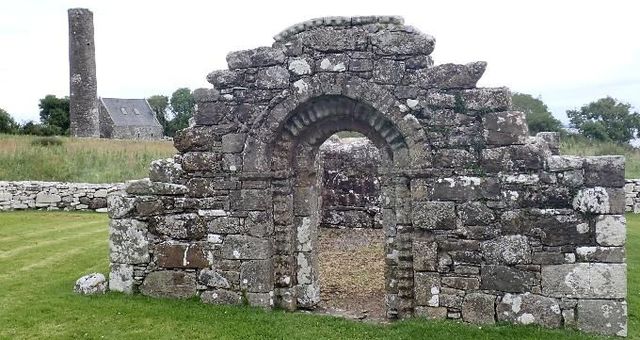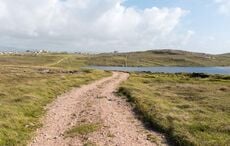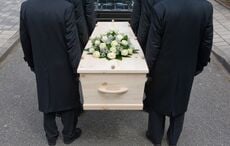Discover the ancient mysteries of Inis Cealtra, or Holy Island, located in County Clare, Ireland. This article explores the island's rich history and spiritual significance, from its monastic ruins to its unique cultural heritage.
"Round Lough Derg's holy island I went upon the stones,
I prayed at all the Stations upon my marrow bones,
And there I found an old man, and though, I prayed all-day
And that old man beside me, nothing would he say."
- From “The Pilgrim” by William Butler Yeats.
My wife, Lindy, and I have been traveling to Ireland nearly every year since 2007, with three years off thanks to COVID. We’ve stayed in cottages all around the island, so we’ve seen all the well-known tourist attractions like the Cliffs of Moher, the Rock of Cashel, the Ring of Kerry, and others, some more than once. These and other famous sites should be seen by anyone who travels to Ireland, and most bus tours will include all or at least some of them.
If you want to immerse yourself in Ireland’s ancient cultural and historic sites, though, you need to rent a car and get to some of the places the buses never go. To be fair, some of the places I’m talking about are down roads no bus would, or should, ever attempt to go. On our most recent trip, we visited one of these “roads not (often) taken” places. Actually, at the end of this road, you have to take a boat.
The place is called Inis Cealtra (“island of the burials” or "of monastic cells" or possibly just “Church Island”), but now it is often simply called “The Holy Island.” It is located on Lough Derg, the largest lake on the Shannon River.
The lake has Clare and Galway on its northern shore and Tipperary on its southern shore. The island is one of the oldest monastic sites in Ireland. Before that, it was inhabited by Christian hermits who claimed it had a “tree whose juice had the flavor of honey and the headiness of wine.”
We failed to locate that tree while we were out there.
It is believed that St. Colum founded the first monastery on the island around 520 AD. However, all historical records from the period are hazy. St. Caimin, who was said to be the half-brother of Guare, King of Connaught, founded a famous school there in the following century. The island was recognized as one of the foremost monastic sites in Ireland and added to a list of properties submitted to UNESCO for future nomination to the World Heritage List in March 2010.
At one time the island was alive with activity, as monks and priests populated the island. It also became a center of education. Thousands from around Ireland would make pilgrimages to the island. This was during the period after the end of the Roman Empire when Irish monks helped keep Christianity alive in many parts of Western Europe.
Like most monastic sites in Ireland, Inis Cealtra became a target for plundering Vikings during the 9th and 10th centuries. The Shannon was a natural passageway into the interior for the seaborne Vikings. The Vikings came up the Shannon and sacked and burned the monastery at least twice, in 836 and again in 922.
The Viking leader Turgesius led the raid up the Shannon in 836. After sacking Inis Cealtra, they continued upriver and plundered the monastic community at Clonmacnoise. One grave on the island is thought to contain the bodies of ten monks who were slaughtered in this raid. The attack in 922 was said to have been led by Tomran.
Brian Boru, the Irish leader credited with ending the power of the Norsemen in Ireland, was born in Killaloe, Co. Clare, just down the river from the Holy Island. His brother, Marcan, was Bishop-Abbot of Holy Island, Terryglass and Killaloe in the 10th Century. Brian was said to have visited the island many times and helped in the building of St. Caimin's Church and the round tower.

Are you planning a vacation in Ireland? Looking for advice or want to share some great memories? Join our Irish travel Facebook group.
The monastic site managed to continue through two centuries of Viking incursions into Ireland and survived for another five centuries. What the Holy Island and the other Irish monastic sites could not survive was the raging hormones and marital problems of Henry VIII. When Henry extended the Act of Supremacy to include Ireland in 1537, the death knell sounded for monastic sites like the Holy Island. It would be hard to estimate how British and Irish history would be changed if Henry VIII had never laid eyes on Anne Boleyn
After that, the only official church in Ireland was the Protestant “Church of Ireland.” The Crown confiscated all the property of the Catholic Church. Henry and those Irish noblemen who stayed loyal to him basically did the same thing the Vikings had done, plundering the Catholic Church in Ireland. They did it far better than the Vikings, however, as they did it “legally.” By the beginning of the 17th century, the roofs of all the churches on the Holy Island were gone.
In the present, Gerard Madden (above) a historian and tour guide who has written several books on local history, including one on Inis Cealtra, will take you to the island on his small boat from the little port town of Mount Shannon, Co. Clare. Needless to say, Ger has a wealth of knowledge about the history of the island. He has been bringing people to the island for 34 years now. With the weather threatening rain, we were Ger’s only passengers on the early July afternoon that we made the trip.
The island is oval and covers about 50 acres. As you approach it in the boat, its most prominent feature is an 80-foot-high round tower seen above the tree line. It is believed to date to the 11th or 12th century. The conical top is missing. In 1980, archeological researchers were unable to find it, indicating that it was never there. Legend has it that the stonemason was distracted by a beautiful witch. There are also the remains of six ancient churches on the island and a holy well.
Leaving the small dock area and walking up over the hill, you will soon see St. Caimin’s Church. It is the only one of the ancient churches with a reconstructed roof and is right next to it is the round tower. You are liable to come upon some of the sheep that graze on the island, like this momma and two cute lambs that we startled as they were coming down the path (above). They took a wide berth around us.
As you walk past the round tower, the first thing that you will notice above the western entrance to St. Caimin’s are some carved faces in the arch above it. Though you can’t enter the church, be sure to go up to the door and look inside. Against both side walls, you will see a number of stone crosses and flat stones with crosses carved into them. It’s not hard to imagine a stone mason with a hammer and chisel working to produce them a thousand or more years ago.
To the right and behind the church are two cemeteries. The one to the right contains more “modern” burials, which in this case means most are not more than about 150 years old. Behind the church is the “Saints Graveyard,” which contains burials going back a thousand years and more.
There are at least two Irish-born men who served in the US Army buried on the island. Among the newer stones near St. Caimin's is the grave of WWI veteran Michael J. Cleary. Near St. Mary' is the stone of WWII veteran Thomas M.. Keenan. You can see photos of their stones in the comments below the article.
To the left of the St. Caimin’s is the remains of a small stone building that is one of the most unusual ancient buildings in Ireland. It is called “The Confessional” (below) as it was used for that purpose in the 18th and 19th centuries, but no one is sure of its original purpose. There are standing stones within that partition the inner space into sections. It is speculated that it could have been built as a location for pilgrims to see religious relics. Religious relics played a significant role in the early Christian churches in Europe.
If it was made to display relics, it may have sometimes had people lined up like some modern-day amusement park ride. Sir Arthur Chichester complained that 15,000 people were crowding the island in 1609. In the late 17th century, English journalist Thomas Dyneley reported that “here once a year the superstitious Irish go to do penance and are enjoined to walk around barefooted seven times and they who fear hurting their feet hire others to do it.” Whether “substitute Holy Island walker” was a viable job in the area is not known.
Moving southeast on the mowed path from St. Caimin’s, you come to a low wall that encloses the ruins of St. Brigid’s Church (below), sometimes also called the Baptism Church. There is a beautiful stone-arched entrance on the south side of the wall and another one on the entrance to the church. It was heavily damaged in 1839, during the night of the infamous “Big Wind.”
Just south of that, also surrounded by a low stone wall, is St. Mary’s Church (in the background above). Built-in the early 13th century, it replaced St. Caimin’s as the main church of the island. The altar at the far end of the church was made from a 17th-century box tomb. It had been moved to a church in Whitegate, Co. Clare, and was converted into an altar. In 1880 it was returned to St. Mary’s.
Just to the southeast of St. Mary’s is a holy well, sometimes called the “Lady’s Well.” It was the final stage of the pilgrimages of the 18th and 19th centuries. The pilgrims would lean over and look down into the water with the legend saying that if you saw yourself in the water, your sins were forgiven.
The poet and Nobel Laureate William Butler Yeats (1865-1939), who lived for a while not far away in the restored Norman Castle of Thoor Ballylee, mentioned Inis Cealtra and Lough Derg in his ballad “The Pilgrim.
Walking through this monastic site, the connection to our ancestors is palpable. If the stones of these ancient buildings could talk, what tales they could tell? If you are interested in Irish history and culture and will be in the Clare, Galway, or Tipperary area shortly, or if you live in the area, take the short boat ride out to Inis Cealtra. It will be a “Road Not (Often) Taken” that you will not regret or forget.
This article was submitted to the IrishCentral contributors network by a member of the global Irish community. To become an IrishCentral contributor click here.




Comments